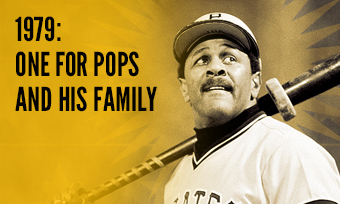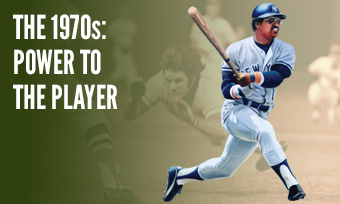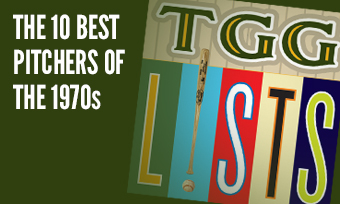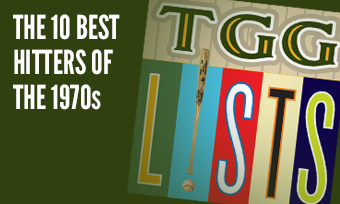The Yearly Reader
Leaders and Honors, 1979
Our list of baseball’s top 10 hitters and pitchers in both the American League and National League for the 1979 baseball season, as well as the awards and honors given to the game’s top achievers of the year.
The National League’s Top 10 Hitters, 1979
Bold type in brick red indicates league leader.
1. Keith Hernandez, St. Louis
Key Numbers: .344 average, 116 runs, 210 hits, 48 doubles, 11 triples, 11 home runs, 105 RBIs, 80 walks, 11 stolen bases.
Hernandez was that “other guy” who the shared the NL MVP with Willie Stargell—not for his inspiration but, instead, for outright performance.
2. Dave Winfield, San Diego
Key Numbers: .308 average, 97 runs, 184 hits, 27 doubles, 10 triples, 34 home runs, 118 RBIs, 85 walks, 24 intentional walks, 15 stolen bases.
Trusting the calculations of Winfield’s complete All-Star effort on the WAR (wins above replacement) front, the Padres would have had the NL’s worst record (60-101) if they had played the replacement all year.
3. Mike Schmidt, Philadelphia
Key Numbers: .253 average, 109 runs, 25 doubles, 45 home runs, 114 RBIs, 120 walks, 9 sacrifice flies.
After a most disappointing (21 home runs, 78 RBIs) 1978 campaign, Schmidt quickly ascended toward his career peak period by doubling his HR count; 29 of them came away from Veterans Stadium.
4. Dave Parker, Pittsburgh
Key Numbers: .310 average, 109 runs, 193 hits, 45 doubles, 7 triples, 25 home runs, 94 RBIs, 20 stolen bases, 9 sacrifice flies.
Another strong year for the reigning NL MVP, but the pressure of a lucrative new contract and intensifying friction with Pirates fans began to take its toll on a man who once told Sports Illustrated: “There’s only thing bigger than me, and that’s my ego.”
5. Dave Kingman, Chicago
Key Numbers: .288 average, 97 runs, 19 doubles, 5 triples, 48 home runs, 115 RBIs, 131 strikeouts, .613 slugging percentage.
The all-or-nothing slugger not only set a career high in home runs, but actually did it with a respectable batting average. Three of his blasts—including a monster 550-foot shot that landed in the porch of the third house away from Wrigley Field—came on a single day in a 23-22 loss to the Phillies.
6. Davey Lopes, Los Angeles
Key Numbers: .265 average, 109 runs, 20 doubles, 6 triples, 28 home runs, 73 RBIs, 97 walks, 44 stolen bases, 4 caught stealing.
Lopes powered up in the leadoff spot with a career-high spike in home runs, while continuing to be the toughest guy to catch stealing.
7. Gary Matthews, Atlanta
Key Numbers: 162 games, .304 average, 97 runs, 192 hits, 34 doubles, 5 triples, 27 home runs, 90 RBIs, 18 stolen bases.
In his third year with the Braves, Matthews finally had the kind of year Atlanta owner Ted Turner had in mind when he did all he could—including illegal tampering, leading to a year-long suspension—to secure him to a big contract.
8. George Foster, Cincinnati
Key Numbers: 121 games, .302 average, 30 home runs, 98 RBIs.
Though some look at the back of the baseball card and see continued dwindling production from Foster, the fact is he would have roughly matched his 1978 totals (40 home runs, 120 RBIs) had he not missed some 35-40 games due to injury.
9. Pete Rose, Philadelphia
Key Numbers: 163 games, .331 average, 90 runs, 208 hits, 40 doubles, 5 triples, 4 home runs, 59 RBIs, 95 walks, 20 stolen bases, .418 on-base percentage.
After 16 years in Cincinnati, a change of scenery did not affect Rose in his first campaign at Philadelphia; in some ways, it actually enlivened him—stealing a career-high 20 bases at age 38.
10. Lee Mazzilli, New York
Key Numbers: .303 average, 78 runs, 181 hits, 34 doubles, 15 home runs, 79 RBIs, 93 walks, 34 stolen bases.
The Brooklyn native attracted male Mets fans for his hitting—and female ones for his good looks.
The American League’s Top 10 Hitters, 1979
1. Fred Lynn, Boston
Key Numbers: 147 games, .333 average, 116 runs, 177 hits, 42 doubles, 39 home runs, 122 RBIs, 82 walks, .423 on-base percentage, .637 slugging percentage.
Four years after his memorable breakout 1975 season followed by three years of statistical ennui, Lynn easily had his most prodigious set of numbers—and became the first AL batting champ to represent the Eastern Division since the league split geographically in 1969. His 28 home runs at Fenway Park alone was a record for a left-handed batter.
2. Jim Rice, Boston
Key Numbers: .325 average, 117 runs, 201 hits, 39 doubles, 6 triples, 39 home runs, 130 RBIs.
In a superb follow-up to his monster 1978 MVP feat, Rice all but matched Lynn in almost every key offensive category—even in the home splits, as he too hit the majority of his home runs at Fenway (27, to go with a .369 average).
3. Don Baylor, California
Key Numbers: 162 games, .296 average, 120 runs, 186 hits, 33 doubles, 36 home runs, 139 RBIs, 11 hit-by-pitches, 22 stolen bases.
It was all about the runs for Baylor, who led the AL in both runs and RBIs and never knocked in more than 100 in any of 18 other seasons; fittingly, he had the most ribbies in a single game, with eight against Toronto on August 25.
4. George Brett, Kansas City
Key Numbers: .329 average, 119 runs, 212 hits, 42 doubles, 20 triples, 23 home runs, 107 RBIs, 17 stolen bases.
Brett became the first player to go 20-20-20 (doubles-triples-home runs) since 1957; it therefore only made sense that he hit for his first career cycle.
5. Sixto Lezcano, Milwaukee
Key Numbers: 138 games, .321 average, 84 runs, 29 doubles, 28 home runs, 101 RBIs, 77 walks.
One of three players with 100-plus RBIs in a rapidly potent Brewers lineup, the 25-year-old Puerto Rico native justified his rare upgrade from part-time duty with a helluva year; he hit .411 against lefties.
6. Darrell Porter, Kansas City
Key Numbers: .291 average, 101 runs, 23 doubles, 10 triples, 20 home runs, 112 RBIs, 121 walks, 13 sacrifice flies.
Porter became the first AL catcher with 10 triples since 1935, and for the only time in his career surpassed 100 in RBIs, runs and walks.
7. Ken Singleton, Baltimore
Key Numbers: .295 average, 93 runs, 29 doubles, 35 home runs, 111 RBIs, 109 walks, 16 intentional walks.
The underrated Singleton got attention from MVP voters by finishing a distant second behind Don Baylor in the final count.
8. Steve Kemp, Detroit
Key Numbers: 134 games, .318 average, 88 runs, 26 doubles, 26 home runs, 105 RBIs.
After a couple noteworthy seasons to begin his career, Kemp hit peak form and especially lived for daytime baseball—hitting .420 in 38 midday games.
9. Cecil Cooper, Milwaukee
Key Numbers: .308 average, 83 runs, 182 hits, 44 doubles, 24 home runs, 106 RBIs, 15 stolen bases.
After early-career frustration in Boston, Cooper continued to enjoy life in Milwaukee—hitting over .300 for a third straight year for the Brewers—and better yet, began to ramp up his power production.
10. Gorman Thomas, Milwaukee
Key Numbers: .244 average, 97 runs, 29 doubles, 45 home runs, 123 RBIs, 98 walks, 175 strikeouts.
While Cubs fans embraced Dave Kingman, Brewers fans just 90 miles up the road in Milwaukee were enjoying the similar exploits of the brawny, mustached Thomas.
The National League’s Top 10 Pitchers, 1979
1. J.R. Richard, Houston
Key Numbers: 2.71 ERA, 18 wins, 13 losses, 38 starts, 292.1 innings, 98 walks, 313 strikeouts, 19 wild pitches, 28 stolen bases allowed.
With 313 strikeouts, Richard broke his own NL record among right-handers of a year earlier; by not allowing a run over his last 25.1 innings, he captured the first ERA title ever earned by an Astro.
2. Joe Niekro, Houston
Key Numbers: 3.00 ERA, 21 wins, 11 losses, 38 starts, 5 shutouts, 264 innings, 107 walks, 19 wild pitches, 31 stolen bases allowed, 27 grounded into double plays.
Niekro was happy to tie his brother, Phil Niekro, in victories—and even happier not to tie him in defeats.
3. Ken Forsch, Houston
Key Numbers: 3.04 ERA, 11 wins, 6 losses, 24 starts, 177.2 innings, 35 walks.
Forsch’s season got off to a great start by throwing a no-hitter in his first appearance—joining brother Bob, who threw a no-no in his second start of 1978.
4. Tom Seaver, Cincinnati
Key Numbers: 3.14 ERA, 16 wins, 6 losses, .727 win percentage, 32 starts, 5 shutouts, 215 innings, 27 stolen bases allowed.
Back issues doomed Seaver with a rough start, but he recovered to star form—going 14-1 with a 2.42 ERA from June 9 to the end of the year.
5. Kent Tekulve, Pittsburgh
Key Numbers: 2.75 ERA, 10 wins, 8 losses, 31 saves, 94 appearances, 134.1 innings, 20 intentional walks.
One of the oddest-looking characters who’d ever see on the field, the lanky, thin submariner with tinted glasses that looked to have been purchased off a rotating grocery store display emerged as a top closer, saving 31 games for a second straight season.
6. Burt Hooton, Los Angeles
Key Numbers: 2.97 ERA, 11 wins, 10 losses, 29 starts, 212 innings.
Wins were hard to come by for the Dodgers’ best pitcher on the year; nine of the 19 games he didn’t get a win in were decided by a single run.
7. Tom Hume, Cincinnati
Key Numbers: 2.76 ERA, 10 wins, 9 losses, 17 saves, 57 appearances, 12 starts, 163 innings, 33 walks.
The home-grown Red was a then-rare case of a starter being converted to relief, and for the better; once permanently moved into the closer role in late August, he saved 15 games, won four others, sported a nifty 1.45 ERA—and was key to the Reds going 37-22 down the stretch to win the NL West.
8. Gaylord Perry, San Diego
Key Numbers: 3.06 ERA, 12 wins, 11 losses, 32 starts, 232.2 innings.
Likely emboldened by his pedigree and age (40), Perry was not only afraid to criticize Padres players and coaches, but also to bolt the team in early September as he demanded a trade back to Texas—which he eventually got.
9. Phil Niekro, Atlanta
Key Numbers: 3.39 ERA, 21 wins, 20 losses, 44 starts, 23 complete games, 342 innings, 113 walks, 18 wild pitches, 11 hit-by-pitches, 40 stolen bases allowed, 25 grounded into double plays.
Niekro became the first major leaguer to lead his league in both wins and losses in the same year.
10. Bruce Sutter, Chicago
Key Numbers: 2.22 ERA, 6 wins, 6 losses, 37 saves, 10 blown saves, 62 appearances, 101.1 innings.
Sutter became the third full-time NL reliever (after Jim Konstanty and Mike Marshall) to win Cy Young Award honors, and barely—finishing just ahead of Joe Niekro.
The American League’s Top 10 Pitchers, 1979
1. Tommy John, New York
Key Numbers: 2.96 ERA, 21 wins, 9 losses, .700 win percentage, 36 starts, 276.1 innings, 11 wild pitches, 45 grounded into double plays.
Goodbye L.A., hello New York: John took his amazing post-Tommy John surgery act to the Big Apple and only got better.
2. Jim Kern, Texas
Key Numbers: 1.57 ERA, 13 wins, 5 losses, .722 win percentage, 29 saves, 9 blown saves, 71 appearances, 143 innings.
A year it all came together for the tall, scruffy and often wacky Kern, who definitely earned the nickname “Emu”; he would leverage the brand to a post-baseball life running an outdoorsman adventure company called the Emu Outfitting Company.
3. Mike Flanagan, Baltimore
Key Numbers: 3.08 ERA, 23 wins, 9 losses, .719 win percentage, 38 starts, 5 shutouts, 265.2 innings, 29 grounded into double plays.
Flanagan became the latest in a string of Orioles hurlers who rose to flash-in-the-pan prominence amid a career of average results (see also Wayne Garland, Rudy May and Steve Stone); he was a near-unanimous choice for the AL Cy Young.
4. Ron Guidry, New York
Key Numbers: 2.78 ERA, 18 wins, 8 losses, .692 win percentage, 2 saves, 33 appearances, 30 starts, 236.1 innings, 24 grounded into double plays.
Though his ERA rose by nearly a run over his brilliant 1978 figure, it was still enough to earn a second straight title in the category.
5. Jerry Koosman, Minnesota
Key Numbers: 3.38 ERA, 20 wins, 13 losses, 36 starts, 263.2 innings, 16 caught stealing/picked off, 29 grounded into double plays.
After going 11-35 despite a fair 3.60 ERA with the derelict Mets over the previous two years, Koosman found both refuge and support in Minnesota.
6. Mike Caldwell, Milwaukee
Key Numbers: 3.29 ERA, 16 wins, 6 losses, .727 win percentage, 31 starts, 235 innings, 39 walks, 26 grounded into double plays.
A subdued yet still effective follow-up to his prodigious comeback of 1978, Caldwell ran his record up to 38-15 over two seasons—after going just 13-28 through the three years before that.
7. Geoff Zahn, Minnesota
Key Numbers: 3.57 ERA, 13 wins, 7 losses, 24 starts, 169 innings, 41 walks, 26 grounded into double plays.
The 33-year-old southpaw dealt with shoulder issues but managed to maintain a steady level of quality pitching throughout the season, as opponents had a hard time trying to make solid contact off of him.
8. Mike Marshall, Minnesota
Key Numbers: 2.66 ERA, 10 wins, 15 losses, 32 saves, 10 blown saves, 90 appearances, 1 start, 142.2 innings, 21 grounded into double plays.
Marshall finally re-approached the heights of his tireless (106 appearances) 1974 campaign, and his eight wins by the end of May had people wondering if he’d be the first full-time reliever to win 20; alas, he only grabbed two more victories the rest of the year, and then did a quick fade—exacerbated, he claims, by being blackballed for his role as a player rep and confrontational thorn in management’s side.
9. Jim Palmer, Baltimore
Key Numbers: 3.30 ERA, 10 wins, 6 losses, 22 starts, 156.2 innings.
The 33-year-old Orioles ace threw well despite numerous sore spots in his back, arm, elbow—and feelings, as some theorized that he was playing up the pains to forge a better contract.
10. Aurelio Lopez, Detroit
Key Numbers: 2.41 ERA, 10 wins, 5 losses, 21 saves, 61 appearances, 127 innings.
After failing to make a go of it in Kansas City and St. Louis, the 20-year old from Mexico found his calling in Detroit, saving 21 games for the first of two straight years while becoming a mainstay in Tigers bullpen through 1985.









